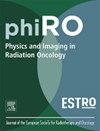Physics-based data augmentation for improved training of cone-beam computed tomography auto-segmentation of the female pelvis
IF 3.4
Q2 ONCOLOGY
引用次数: 0
Abstract
Background and Purpose
Labeling cone-beam computed tomography (CBCT) images is challenging due to poor image quality. Training auto-segmentation models without labelled data often involves deep-learning to generate synthetic CBCTs (sCBCT) from planning CTs (pCT), which can result in anatomical mismatches and inaccurate labels. To prevent this issue, this study assesses an auto-segmentation model for female pelvic CBCT scans exclusively trained on delineated pCTs, which were transformed into sCBCT using a physics-driven approach.
Materials and Methods
To replicate CBCT noise and artefacts, a physics-driven sCBCT (Ph-sCBCT) was synthesized from pCT images using water-phantom CBCT scans. A 3D nn-UNet model was trained for auto-segmentation of cervical cancer CBCTs using Ph-sCBCT images with pCT contours. This study included female pelvic patients: 63 for training, 16 for validation and 20 each for testing on Ph-sCBCTs and clinical CBCTs. Auto-segmentations of bladder, rectum and clinical target volume (CTV) were evaluated using Dice Similarity Coefficient (DSC) and 95th percentile Hausdorff Distance (HD95). Initial evaluation occurred on Ph-sCBCTs before testing generalizability on clinical CBCTs.
Results
The model auto-segmentation performed well on Ph-sCBCT images and generalized well to clinical CBCTs, yielding median DSC’s of 0.96 and 0.94 for the bladder, 0.88 and 0.81 for the rectum, and 0.89 and 0.82 for the CTV on Ph-sCBCT and clinical CBCT, respectively. Median HD95′s for the CTV were 5 mm on Ph-sCBCT and 7 mm on clinical CBCT.
Conclusions
This study demonstrates the successful training of auto-segmentation model for female pelvic CBCT images, without necessarily delineating CBCTs manually.
基于物理学的数据增强技术,用于改进女性骨盆锥形束计算机断层扫描自动分割的训练
背景与目的锥形束计算机断层扫描(CBCT)图像由于图像质量差而具有挑战性。训练没有标记数据的自动分割模型通常涉及深度学习,以从计划ct (pCT)生成合成cbct (sCBCT),这可能导致解剖不匹配和标签不准确。为了防止这一问题,本研究评估了一种女性骨盆CBCT扫描的自动分割模型,该模型专门训练了划定的pct,并使用物理驱动的方法将其转换为sCBCT。为了复制CBCT噪声和伪影,利用水影CBCT扫描的pCT图像合成了物理驱动的sCBCT (Ph-sCBCT)。利用具有pCT轮廓的Ph-sCBCT图像,训练了一个三维nn-UNet模型,用于宫颈癌cbct的自动分割。本研究包括女性盆腔患者:63例用于训练,16例用于验证,各20例用于ph - scbct和临床cbct测试。采用Dice Similarity Coefficient (DSC)和第95百分位Hausdorff Distance (HD95)评价膀胱、直肠和临床靶体积(CTV)的自动分割。在测试临床cbct的普遍性之前,对ph - scbct进行了初步评估。结果该模型对Ph-sCBCT图像的自动分割效果良好,对临床CBCT的自动分割效果也很好,膀胱的DSC中值分别为0.96和0.94,直肠的DSC中值分别为0.88和0.81,CTV在Ph-sCBCT和临床CBCT上的DSC中值分别为0.89和0.82。Ph-sCBCT对CTV的中位HD95为5 mm,临床CBCT为7 mm。结论本研究成功地训练了女性骨盆CBCT图像的自动分割模型,无需人工圈定CBCT。
本文章由计算机程序翻译,如有差异,请以英文原文为准。
求助全文
约1分钟内获得全文
求助全文
来源期刊

Physics and Imaging in Radiation Oncology
Physics and Astronomy-Radiation
CiteScore
5.30
自引率
18.90%
发文量
93
审稿时长
6 weeks
 求助内容:
求助内容: 应助结果提醒方式:
应助结果提醒方式:


